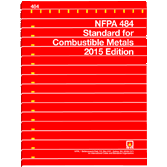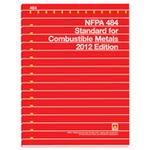NFPA (Fire) 484
Click here to purchase
Codes and standards published by NFPA are displayed as read-only under license from NFPA solely for use within this system. NFPA material may not be downloaded, printed, reproduced, or transferred.
Apply NFPA 484, Standard for Combustible Metals, to help ensure that you meet the most advanced fire and explosion safety requirements related to combustible metals and metal dusts.
NFPA 484, Standard for Combustible Metals, was developed in response to fires where fire suppression water was used inappropriately, often with disastrous results. The standard includes widely accepted safety requirements for any metal that meets its definition of a combustible metal, including alkali metals, aluminum, hafnium, magnesium, niobium, tantalum, titanium, and zirconium. NFPA 484, Standard for Combustible Metals, addresses the production, processing, finishing, handling, storage, use, and recycling of all metals and alloys that are in a form capable of combustion or explosion.
Make sure you understand and follow the requirements for proper dust collection, housekeeping, and identification of potential ignition sources.
It’s important to understand that fire and explosion hazards might be present due to operations involving the production, processing, finishing, handling, recycling, storage, and use of all metals and alloys that are in a form that is capable of combustion or explosion. Operations where metal or metal alloys are subjected to processing or finishing operations that can produce combustible powder or dust are also covered by this standard.
Changes throughout the 2022 edition of NFPA 484, Standard for Combustible Metals, can help you apply the standard correctly in different work environments.
This edition of the standard has been reorganized so that the first nine chapters correlate with the topics covered in NFPA 652, Standard on the Fundamentals of Combustible Dust, as well as to organize the remaining chapters to ensure the first nine chapters do not conflict with other sections of the standard. Chapter 13, Additive Manufacturing, was also revised to address the following:
- The growing utilization of metal powders in additive manufacturing
- Dust hazard analysis
- Location of emergency shutdown controls
- Harvesting printed objects
- Powder storage
- Operator training
Further updates for the 2022 edition of NFPA 484, Standard for Combustible Metals, include the following:
- A new requirement for the Kst value to be doubled for certain metals – unless their explosibility characteristics are determined in a 1 m3 or larger test vessel – has been added, in addition to annex material to help explain this requirement.
- The requirements for fire detection for dry-type air-material separators have been revised to allow for the use of methods other than surface-mounted devices and to require that all filter locations (if present) be monitored.
- Chapter 15, Legacy Metals, has been reorganized to consolidate the requirements that apply to all legacy metals.
Everyone involved with facility fire safety or fire prevention and protection where combustible metals and combustible metal dusts are present needs to use the latest edition of NFPA 484, Standard for Combustible Metals. Order your copy of the 2022 edition today. (Print, Approx. 158 pp., 2022)
Product Details
- Published:
- 09/15/2021
- Number of Pages:
- 160
NFPA (Fire) 484
Click here to purchase
Look to new NFPA 484 for advanced fire and explosion safety around all types of combustible metals and metal dusts.
Reflecting the latest research, testing, and fire experience, the 2015 edition of NFPA 484: Standard for Combustible Metals presents widely accepted safety requirements for any metal that meets the definition of a combustible metal in NFPA 484 — including alkali metals, aluminum, hafnium, magnesium, niobium, tantalum, titanium, and zirconium. NFPA 484 addresses the production, processing, finishing, handling, storage, use and recycling of all metals and alloys that are in a form capable of combustion or explosion.
Make sure you know about proper dust capture or collection, housekeeping, and identification of potential ignition sources.
Compliance with the latest edition of NFPA 484 is critical, as fire and explosion hazards are potentially present from operations involving production, processing, finishing, handling, recycling, storage, and use of all metals and alloys that are in a form that is capable of combustion or explosion. In addition, operations where metal or metal alloys are subjected to processing or finishing operations can produce combustible powder or dust are covered by this Standard.
The 2015 NFPA 484 is updated and reorganized for easier referencing:
- Common requirements for all metal types — such as PPE, management of change, dust collection, ignition sources, and hazard analysis — formerly in Chapters 11 through 18 — have been moved into fundamental Chapters 4 through 9.
- Chapter 4 has revised procedures concerning material characterization and determining combustibility and explosibility for metal dusts. Use of either test data or historical data is now permitted.
- Chapter 5 has new requirements for management systems elements, such as management of change, hazard analysis, and PPE.
- Chapter 7 establishes a threshold for fugitive dust accumulations, which is then used to trigger specific requirements related to dust hazard control.
- Renamed Chapter 8: Ignition Sources addresses the control of ignition sources such as hot work, smoking, spark-resistant tools, static electricity and friction hazards. It also still addresses electrical area classification.
Developed in response to fires where fire suppression water was used inappropriately, NFPA 484 is critical to fire safety.
Product Details
- Published:
- 05/19/2014
- ISBN(s):
- 9781455909070
- Number of Pages:
- 151
NFPA (Fire) 484
Click here to purchase
Apply NFPA 484 for the most advanced fire and explosion safety around all types of combustible metals and metal dusts.
Completely reorganized to align with NFPA 652, Standard on the Fundamentals of Combustible Dust, NFPA 484, Standard for Combustible Metals presents widely accepted safety requirements for any metal that meets the definition of a combustible metal in NFPA 484 — including alkali metals, aluminum, hafnium, magnesium, niobium, tantalum, titanium, and zirconium. NFPA 484 addresses the production, processing, finishing, handling, storage, use, and recycling of all metals and alloys that are in a form capable of combustion or explosion.
Make sure you understand and follow proper dust capture or collection, housekeeping, and identification of potential ignition sources.
NFPA 484 was developed in response to fires where fire suppression water was used inappropriately, often with disastrous results. The reorganized 2019 edition has added material in Chapter 1 that clarifies the application of the standard to mixtures of metals and other combustible nonmetal dusts, and updated definitions in Chapter 3 that correlate with NFPA 652. It?s important to understand that fire and explosion hazards are potentially present from operations involving production, processing, finishing, handling, recycling, storage, and use of all metals and alloys that are in a form that is capable of combustion or explosion. In addition, operations where metal or metal alloys are subjected to processing or finishing operations can produce combustible powder or dust are covered by this standard.
Changes throughout this 2019 edition help you apply requirements correctly in different work environments:
- New Chapter 4, General, includes material on objectives and compliance options, Management of Change, and PPE.
- New Chapter 7 addresses Dust Hazard Analysis.
- Updated Chapter 8 strengthens the provisions regarding static electricity. Revised requirements for electrical area classification spell out differences with NFPA 70®, National Electrical Code®, and that the NEC® zone classification system is not to be used for metal dusts.
- Chapter 11, Powder and Dust Collection and Centralized Vacuum Systems, provides greater clarity on a complex topic.
- New Chapter 12, Nanometals, and new Chapter 13, Additive Manufacturing, reflect emerging technologies and issues in the metals industry.
- Chapter 15, Legacy Metals, consolidates the common requirements for aluminum, magnesium, niobium, tantalum, titanium, zirconium, and hafnium into a single location. Material that is specific to one of these metals remains in the metal-specific chapters.
Everyone involved with facility fire safety or fire prevention and protection where combustible metals and combustible metal dusts are located needs the latest edition of NFPA 484. (Softbound, 158 pp., 2019)
Product Details
- Published:
- 05/24/2018
- Number of Pages:
- 158
NFPA (Fire) 484
Click here to purchase
Rely on the 2012 NFPA 484 for advanced fire and explosion safety around all types of combustible metals and metal dusts.
Reflecting the latest research, testing, and fire experience, the 2012 edition of NFPA 484: Standard for Combustible Metals presents widely accepted safety requirements for any metal that meets the definition of a combustible metal in NFPA 484 — including alkali metals, aluminum, hafnium, magnesium, niobium, tantalum, titanium, and zirconium.Revised for consistency and easy referencing, this edition also features numerous technical changes:
- New information that clarifies the testing/classification of potentially combustible metals and metal dusts including revised wording indicating when the standard is applicable
- “Management of change” requirements in chapters where it was not previously identified as a requirement, with additional information on wet dust collection systems, housekeeping practices that prevent fires and/or explosions, and PPE.
- New Chapter 5 addressing the Determination of Dust Explosion Hazard Areas and Flash-Fire Hazard Areas.
Get the latest facts about retroactive requirements and new applications:
- Chapter 15, Fire Prevention, Fire Protection, and Emergency Response remains retroactive for all facilities that handle, use, process, store or recycle combustible metals or combustible metal dusts.
- Chapter 16, Combustible Metal Recycling Facilities is now retroactive. Additional information was added to address emergency response requirements.
- Process hazard analysis requirements now apply to all combustible metal chapters.
Everyone involved with facility fire safety or fire prevention and protection where combustible metals and/or combustible metal dusts are located, needs this essential document. The Standard was developed in response to fires which involved combustible metals where fire suppression water was used inappropriately. NFPA 484 includes requirements for the production, processing, finishing, handling, storage, use and recycling of all metals and alloys that are in a form capable of combustion or explosion.
Product Details
- Published:
- 08/31/2011
- ISBN(s):
- 9781455901173
- Number of Pages:
- 161
You May Also Like


